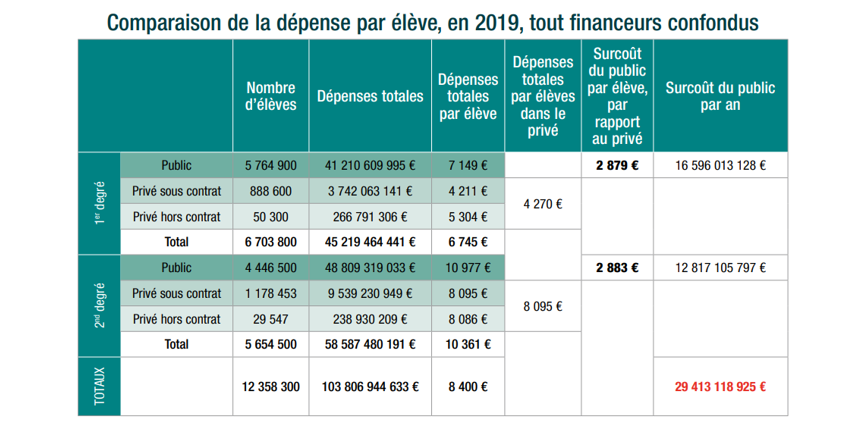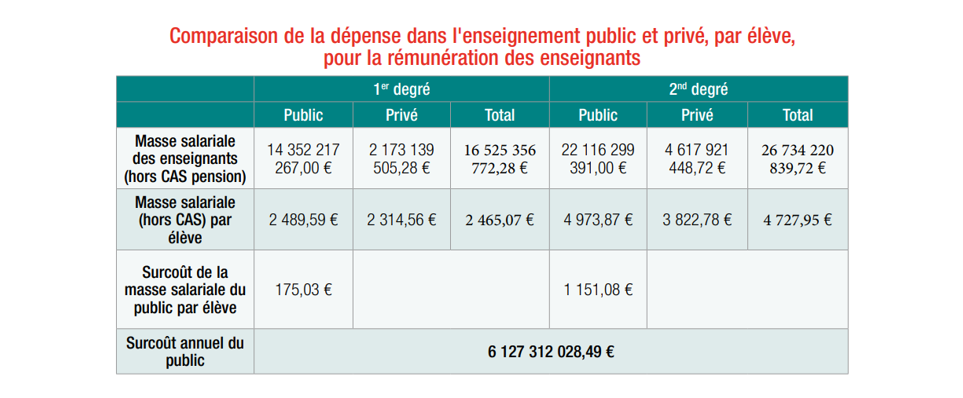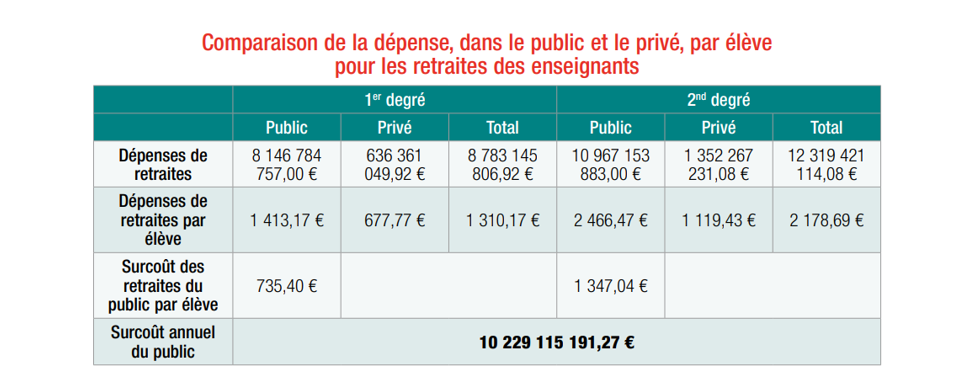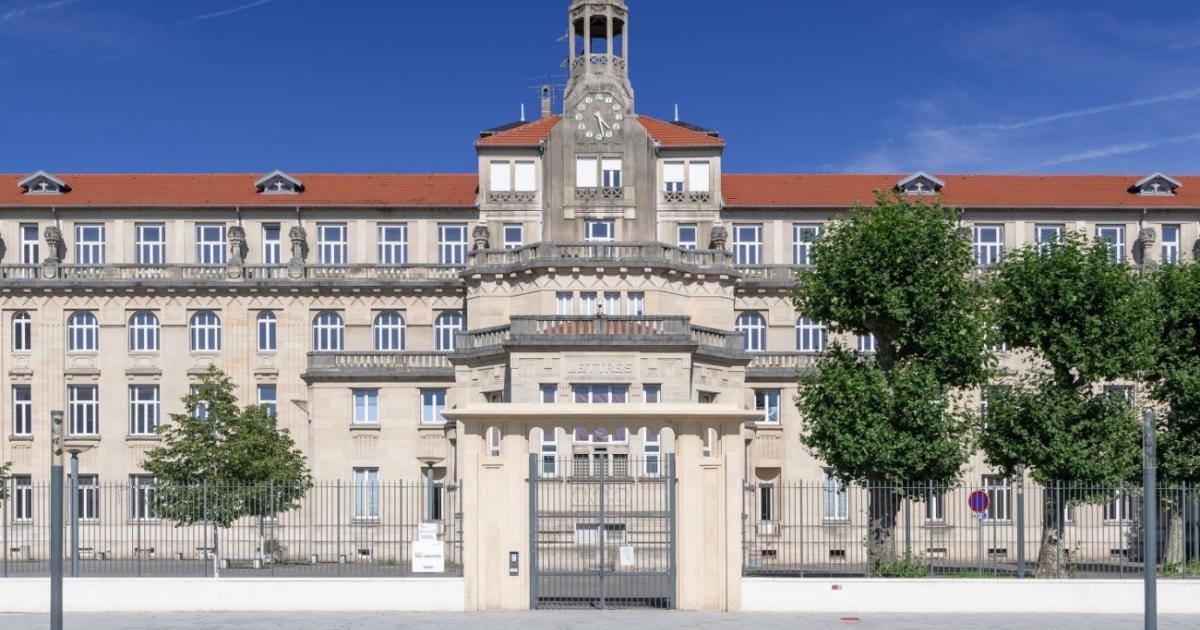The parliamentary report, which was presented at the beginning of April by MPs, LFI, Paul Vannier and Renaissance, Christopher Weissberg, dealt with the financing of private education. If the report highlights the incomplete monitoring and control of public funding flows towards private education, parliamentarians admit that public spending per private student is lower, between -46% and -55%, compared to a public student school. Excessive spending by the public condemned by the IFRAP Foundation since 2014. According to the Foundation, by comparing total related expenditures, public education costs 30% more than private education: a persistent gap over the last decade and representing almost 30 billion euros each year.
Private education cheaper than public education
50% cheaper compared to public spending per student
The report, which includes figures for 2021 from the Department of Financial Affairs (DAF) of the Ministry of National Education, compares public spending per pupil and estimates that the cost of educating a pupil in primary education is 55% lower in private education and 46% lower in secondary school pupil education.

30% cheaper including private expenses (tuition fees, canteens, own funds, etc.)
Note that the parliamentary report only takes into account public spending without including private spending (mainly the institutions' own funds and school fees paid by parents). For the IFRAP Foundation, the inclusion of these costs is essential to compare, on an equal mission, education spending per pupil. In 2019, this comparison revealed a funding shortfall of around 30% resulting from overspending by the public sector compared to the private sector of €29 billion.

If the methodologies differ, we should be delighted to see the cost gap between public and private education officially acknowledged in a parliamentary report. At a time when the state wants to save money and where all the lights are red on the national education side, it is time to rationalize spending on education while freeing up the envelope for financing cost reforms and investing in various priorities (renovation, priority education, bonus for success or attendance, etc. .).
The origin of the difference… and omissions in the report
Private and public teachers: the same job, but very different benefits (and costs)
The report quickly reviews the potential drivers of this differential. He specifically cites “inequities related to teaching staff” who are “less aggregated, more contracted, and more part-time” in private education. The conclusion shared by the IFRAP Foundation is that the additional cost associated with teacher salaries is 6.1 billion compared to the private sector because in fact the private workforce has 4 times as many contract workers while the public also employs 3 times as many 'in total'. Public teachers also benefit from onboarding bonuses, a bonus that private teachers do not have. And the percentage of public teachers in “Zone 1” (and benefiting from a 3% increase in their gross index pay) was higher than in the private sector (21.8% compared to 17%), as well as in overseas departments where they receive a cost-of-living increase (4.8% in the public sector compared to 1.9% in the private sector).

However, it is unfortunate that the report ignores the problem of the weight of public teacher pensions compared to the private sector: the latter represent an additional cost of HRK 10.2 billion. We remind you, no, teachers from the private sector do not have the status of civil servants and if their employer is indeed the state, their pensions fall under the general social security system. So private sector pensions are calculated based on the best 25 years compared to the last six months of a public career. As a result, the average net monthly pension of teachers in the private sector is EUR 2,130 compared to EUR 2,500 in the public sector.

Not dealing with this topic is a mistake because it will be central to any future reform of national education. Indeed, if we compare the average super gross salary (including pensions) between a public teacher in France and Germany, we see that the pension contribution is twice as high in our country and results in a gap of 11,250 euros per French language teacher per year. . This means that if the net salary of a teacher seems lower in France than in Germany, it is because of pension costs, because the public employer actually spends more for a French teacher than for a German teacher (ie 78,479 vs. 76,628 euros per year). In the end, pensions for National Education staff cost €22 billion a year. So, as long as the responsibility for this responsibility remains with the Ministry of National Education and in the absence of public sector pension reform (by 2030, 328,000 new teachers will retire), any policy of improving the teaching staff will be in vain.
Free operating costs in public education, self-managed in the private sector
The report also points to the fact that, in private education, the school building is “not supported by communities” as a factor in the difference in education costs. The investigation on this topic is relatively detailed in the report, which condemns that “the general management of local authorities does not ensure a consolidated monitoring at national level of the amounts paid under the externality package, and this amount is no longer collected by local authority networks (AMF, Departments of France , regions of France) nor the Ministry of National Education. » Certainly, we must regret and correct the fact that there is no consolidation, especially about the number of agents employed in the communities, but numerous figures are circulating and allow us to say that operating costs cost 1200 euros more per public student and per year.
If the employment conditions of public and private teachers have to be harmonized in the long term, savings will have to be made in the long term primarily on these operating costs. At stake: 13 billion euros. This is because private institutions manage to save thanks to the “operational” package per pupil (paid by the communities), the autonomous management of material matters (and where the responsibility of the director of the institution, employed under a private law contract) and the rationalized policy of non-teaching human resources. Indeed, in the private sector under contract, 1 “non-teaching” agent supervises 40% more students than in the public sector.
Administrative costs, donations, social diversity: blind spots persist
The report also cites other deficiencies in tracking budget data and tracking variances. He rightly wants the “administrative service” type expenditures (management of teachers' salaries, inspection service, for example) carried out by the central administration for private education to be separated and added to private spending. They are currently valued at 790 million euros.
It also requires the integration of donations granted to associations of private educational networks, especially OGEC (Managing Organization of Catholic Institutions) or APEL (Association of Parents of Free Education Students). There is actually little information circulating on this issue. We know that in 2019, Catholic Education in the Vendée estimated the investment of OGECs at between 40 and 50 million euros per year to meet especially real estate needs. We also know that in 2021 the Saint Matthieu Foundation collected 5 million donations.
Undoubtedly, the inclusion (or at least the publication of data by the state) of these amounts must be carried out, but, compared to the 13 billion euros of expenditure on private education and 90 billion euros on public education, they should only reduce the spending gap by a few percentages.
The last argument of the parliamentary report: “student-specific differences welcome” where “in public, Depp notes the stronger needs of students due to social origin, (…) proportion of dung, inclusive school”. Undoubtedly, the rapporteurs mention the new indexes of social position (IPS) of educational institutions and the issue of social diversity that hit the headlines in the media at the beginning of the school year in September 2023. For the IFRAP Foundation, this argument cannot justify the difference in costs that oscillates between 25 and 30 % per admitted student. IPS are also indicators that should be taken with a grain of salt: there are more of them and they contradict each other, especially on the education priority map. Finally, and above all, it is not objective to deal with the issue of social diversity in the education system without considering the issue of the distribution of educational institutions by territory. One of the reasons private charter institutions show an IPS, on average, higher than public institutions lies in the map of private education… which is limited by the 80/20 rule. If the 80/20 rule were followed equally throughout the country, more than 330,000 students currently attending public schools would have to be in the private sector, increasing the number of private institutions under contract from 7,600 to 9,200, which would change the educational landscape. automatically affect the current IPS object map.
What to conclude? It should be noted that the failures in the monitoring of public financing of private education and its control, mentioned in the report, systematically fall under the responsibility of the Ministry of National Education or the state. The ongoing uncertainties surrounding the financing of private education are still based on non-centralized data, or never published, and on reports kept secret by the state. How to explain that inspection reports for private institutions are not published automatically? The last one, that of the educational institution Stanislas, whose report submitted to the government in August 2023 has not yet been officially published. Local authorities, responsible for financing the material issue of educational institutions, are also completely excluded from these surveys and their results.
Although we must look forward to the publication of this parliamentary report which recognizes the lower expenditure per pupil in private education compared to public education, many gray areas still exist… However, it is precisely in these areas that the arguments against private contract education and the pseudo “school wars” are born “.
Establishing transparency in the management of private education and its funding, as called for in the report, will highlight the dysfunctions that exist in both private and public education. This transparency should above all allow the comparison of the financial management of the two systems, the individual billing and, in this case, the singling out of missions where the public overspends in order to identify ways to improve and ways to reform.

